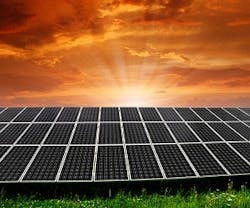New Solar Cell Could Enhance Solar Panel Efficiency
Scientists at the University of Cambridge have developed a hybrid solar cell that could increase the maximum efficiency of solar panels by 25% or more. The research detailing these potential energy gains was published today in Nano Letters.
Traditional solar cells are only capable of capturing part of the light from the sun and much of the energy of the absorbed light, particularly of the blue photons, is lost as heat. This inability to extract the full energy of all of the different colors of light at once means that traditional solar cells are incapable of converting more than 34% of the available sunlight into electrical power.
The hybrid cell can absorb red light and uses the energy of blue light to boost the electrical current. Typically, a solar cell generates a single electron for each photon captured. However, by adding pentacene, an organic semiconductor, the solar cells can generate two electrons for every photon from the blue light spectrum. This could enable the cells to capture 44% of the incoming solar energy.
Bruno Ehrler, the lead author on the paper, says: "Organic and hybrid solar cells have an advantage over current silicon-based technology because they can be produced in large quantities at low cost by roll-to-roll printing. However, much of the cost of a solar power plant is in the land, labor, and installation hardware. As a result, even if organic solar panels are less expensive, we need to improve their efficiency to make them competitive. Otherwise, it'd be like buying a cheap painting, only to find out you need an expensive frame."
